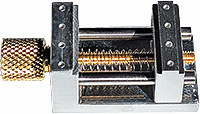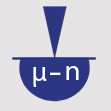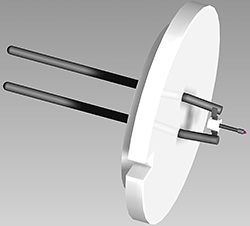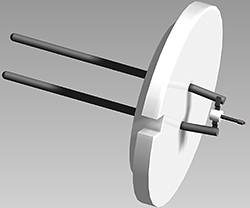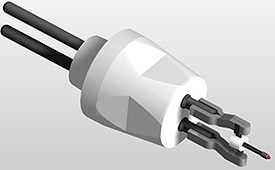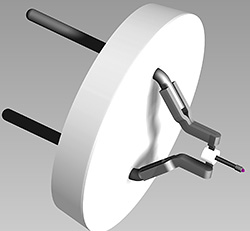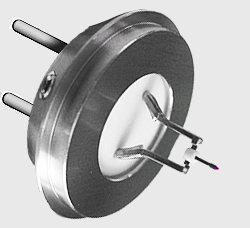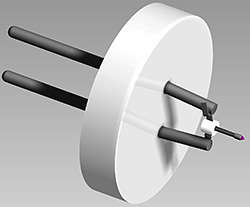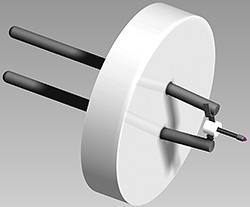
Kimball LaB6 cathodes for SEM and TEM
Kimball LaB6 cathodes for SEM and TEM
High brightness, high stability, robust long-life LaB6 cathodes
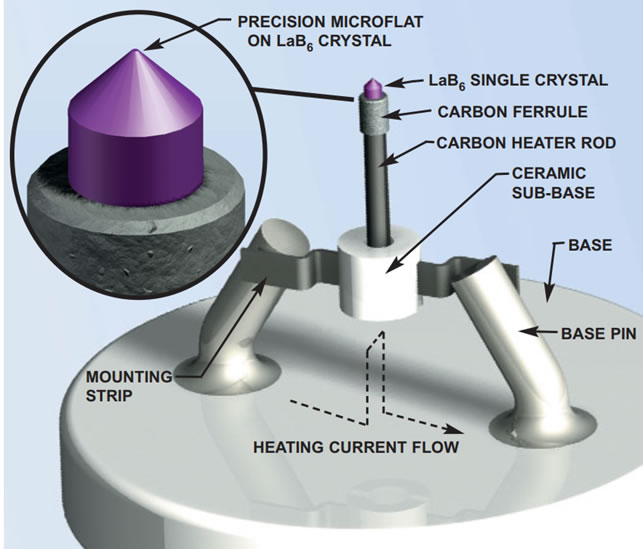
Kimball LaB6 cathodes for SEM and TEM
Introduction
The Kimball LaB6 filaments are the industry standard, high quality LaB6 cathodes. The standard LaB6 cathode comprises a 90° tip angle and a 15µm flat made from a <100> oriented single crystal. This provides a long lifetime, high brightness source coupled with excellent stability. The special version with sharper 60° tip angle and smaller 6µm flat is available for TEMs.
Kimball Physics uses the purest, high quality LaB6 crystals for the Kimball ES-423E LaB6 cathodes. The standard Kimball LaB6 tip provides a 10x higher brightness as the standard tungsten source, resulting in better resolution with clear images and less noise. The lifetime of an LaB6 cathode is much longer than a tungsten source providing a stable source over a longer period.
See the electron source performance table for more details.
The Kimball LaB6 cathodes improve results when used for:
- SEM for low voltage and long term EDS mapping applications
- TEM imaging and analysis
- Electron probe micro analyzers (EPMA or Microprobe)
- E-beam lithography

The Kimball LaB6 cathodes are available with three types of LaB6 tips:
1 – Standard tip with 90° cone and 15 µm micro-flat for standard SEM and standard TEM applications
2 – Long life, high stability tip with 90° cone and 20 µm micro-flat for Microprobes and analytical SEM applications
3 – High brightness, sharp tip with 60° cone and 6 µm micro-flat for high resolution TEM applications
LaB6 sources require a higher vacuum than standard tungsten sources which generally requires an additional ion-getter pump at the electron source. The required vacuum is in the 10-7 mbar range.
Design and features of the Kimball ES-423E LaB6 cathodes
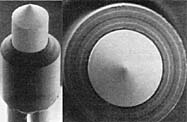 The Kimball Physics ES-423E (extended life) LaB6 cathode is a high performance, resistively heated, thermionic electron source. It is based on a well proven carbon rod heater structure with improved stability, improved reliability and less exposure of the LaB6 crystal to reduce contamination of the Wehnelt aperture. There is heating current through the LaB6 crystal; there are no high-temperature current carrying joints. The LaB6 crystal is held in place by a carbon ferrule. The design results in a small physical size which fits most Wehnelt cylinder with ease. Benefits of this unique construction are:
The Kimball Physics ES-423E (extended life) LaB6 cathode is a high performance, resistively heated, thermionic electron source. It is based on a well proven carbon rod heater structure with improved stability, improved reliability and less exposure of the LaB6 crystal to reduce contamination of the Wehnelt aperture. There is heating current through the LaB6 crystal; there are no high-temperature current carrying joints. The LaB6 crystal is held in place by a carbon ferrule. The design results in a small physical size which fits most Wehnelt cylinder with ease. Benefits of this unique construction are:
- Suitable for SEM, TEM, Microprobes and E-Beam lithography systems
- Resistively, indirectly heated high purity LaB6 crystal, resulting in lower heating current
- High thermal stability to eliminate drift problems
- Carbon ferrule with less exposure of LaB6 crystal to reduce Wehnelt contamination
- low vapour pressure with reduced evaporation loss
- High brightness; about 10x higher than tungsten filaments (even 20x for the sharper tips)
- Stable sources; due to its sturdy construction, the standard Kimball LaB6 cathodes comprise a stability of better than 3%/hour at 1550°C
- Long life; at 10-7mbar vacuum and 1550°C operating temperature, >500 hours lifetime can be expected for the standard Kimball ES-423E LaB6 cathode
- Low work function of 2.66ev (compared to 4.7ev for tungsten)
Further details and specifications of the Kimball ES423E LaB6 can be found in these PDFs: Kimball ES-423E extended life LaB6 cathode specifications and Kimball ES-423E extended life LaB6 cathode user information
Specifications of the different Kimball ES-423E LaB6 cathodes
Please consult the following table for the correct type of Kimball LaB6 source or cathode for your SEM, TEM or Microprobe. The Kimball Physics LAB6 cathodes are available for Thermo, FEI, Hitachi, JEOL, Amray, CamScan, ISI, ABT, Topcon, Philips, Tescan, Zeiss, LEO, Leica, Cambridge Instruments and Leica electron microscopes.
| Type | Standard tip |
Long life, high stability tip |
High brightness sharp tip |
Tip shape |
90°tip angle with 15µm flat |
90°tip angle with 20µm flat |
60°tip angle with 6µm flat |
Brightness |
10x times than tungsten tip |
2 x less than standard tip |
2x times than standard tip |
Saturation |
Mono spot at around 1550°C |
Mono spot at around 1550°C |
Mono spot at around 1550°C |
Crossover |
Small; 7-10µm |
Small; 7-10µm |
Small; 7-10µm |
Angular distribution |
Sharp; 1.6 x 10-2 rad |
Sharp; 1.6 x 10-2 rad |
Sharp; 1.6 x 10-2 rad |
Lifetime |
Long > 500 hrs |
Longer than standard tip |
Shorter than standard tip |
Ease of operation |
Moderate |
Easy, due to larger spot |
Difficult, due smaller spot |
Stability |
High, better than 3%/hr |
High, better than 3%/hr |
Lower, due to smaller spot |
Vacuum |
10-7 mbar or better |
10-7 mbar or better |
10-7 mbar or better |
Work function |
2.66 ev |
2.66 ev |
2.66 ev |
Application |
SEM & TEM |
Analytical SEM / Microprobe |
TEM |
Kimball ES-423E LaB6 cathode selection table
Electron Microscope Type or Filament base |
Product number |
Ceramic Disc mm |
Pin Diameter mm |
Pin Pitch mm |
AEI |
12.0 |
1.0 |
6.45 |
|
AmRay /AMR SEM (except 1200 series) |
26.0 |
1.0 |
5.0 |
|
Cambridge Instruments SEM (except S4-10) |
12.0 |
1.0 |
6.45 |
|
CamScan SEM with AEI conversion |
12.0 |
1.0 |
6.45 |
|
FEI SEM and TEM |
26.0 |
1.0 |
5.0 |
|
Hitachi S-Type |
9.8 |
1.2 |
2.7 |
|
JEOL K-Type metal ring – SEM – standard tip |
28.0 |
1.2 |
8.0 |
|
JEOL K-Type metal ring – TEM – sharp tip |
28.0 |
1.2 |
8.0 |
|
Leica SEM |
12.0 |
1.0 |
6.45 |
|
LEO 400 and 1400 Series SEM |
12.0 |
1.0 |
6.45 |
|
LEO1450 SEM (except AEI conversions) |
19.8 |
1.0 |
5.0 |
|
LEO TEM |
19.8 |
1.0 |
5.0 |
|
Philips SEM and TEM (except XL-30) |
26.0 |
1.0 |
5.0 |
|
Philips XL-30 SEM |
12.0 |
1.0 |
6.45 |
|
Tescan SEM |
19.8 |
1.0 |
5.0 |
|
Thermo Sem and TEM |
26.0 |
1.0 |
5.0 |
|
Zeiss DSM SEM and TEM |
19.8 |
1.0 |
5.0 |
|
Zeiss EVO SEM |
12.0 |
1.0 |
6.45 |
Electron Source Performance Table
The electron source performance table is provided to give additional information into the performance and requirements for different type of electron emitters. Tungsten cathodes are still used in many SEMs. Improved results can be obtained with LaB6 cathodes. The highest resolution, highest brightness and best low kV performance can be achieved with either Schottky or cold Field Emission Sources.
Emitter Type |
Thermionic |
Thermionic |
Schottky TFE |
Cold FE |
Tip image comparison |
|
|
|
|
Cathode Material |
W |
LaB6 |
ZrO/W (100) |
W (310) |
Operating Temp (K) |
2700 |
1800 |
1800 |
300 |
Cathode Radius (nm) |
60,000 |
10,000 |
<1000 |
<100 |
Effective Source Radius (µm) |
25 |
10 |
0.015 |
0.0025 |
Emission Current Density (A/cm2) |
3 |
30 |
5300 |
17,000 |
Total Emission Current (µA) |
200 |
80 |
200 |
5 |
Brightness (A/cm2.sr.kV) |
1x104 |
1x105 |
1x107 |
2x107 |
Maximum Probe Current (nA) |
1000 |
1000 |
10 |
0.2 |
Energy Spread @ Cathode (ev) |
0.59 |
0.4 |
0.31 |
0.26 |
Energy Spread @ Source Exit (eV) |
1.5 – 2.5 |
1.3 – 2.5 |
0.35 – 0.7 |
0.3 – 0.7 |
Beam Noise (%) |
1 |
1 |
1 |
5 – 10 |
Emission Current Drift (%/h) |
0.1 |
0.2 |
<0.5 |
5 |
Operating Vacuum (hPa/mbar) |
<10-5 |
<10-6 |
<10-8 |
<10-10 |
Typical Cathode Life (h) |
100 |
>1000 |
>5000 |
>2000 |
Cathode Regeneration (h) |
None |
None |
None |
6-12 |
Sensitivity to External Influences |
Minimal |
Low |
Low |
High |
Stability |
Standard |
High |
Very high |
Low |
X-ray analysis |
EDS / WDS |
EDS / WDS |
EDS / WDS |
EDS |
Additional resources for the Kimball ES-423E extended lifetime LaB6 cathodes:
TSB - Emission - Drift and LaB6 source stability
TSB - Kimball LaB6 cathode operating instructions for Leica Cambridge Instruments SEMs
TSB - Oxygen activation of LaB6 cathodes - The double saturation effect
TSB - Recovery of Emission from Kimball LaB6 following a vacuum dump
TSB - Relationship between LaB6 cathode lifetime and vacuum
TSB - The Kimball LaB6 cathode style 60-6
TSB- General guidelines for operating Kimball LaB6 cathodes
Data Table - LaB6 thermodynamics
Graph - LaB6 surface recession against brightness
Graph - LaB6 surface recession against temperature
|
|
|
|
|
|
|
|
|
|
|
|
|
|
|
|
|
|
|
|
|
|
|
|


